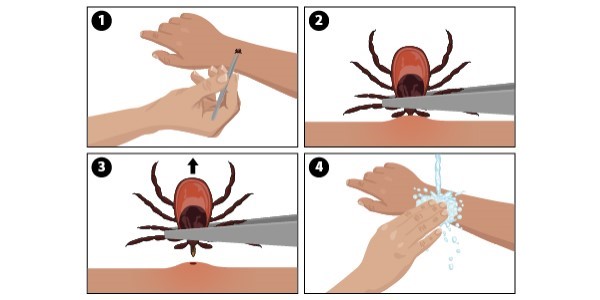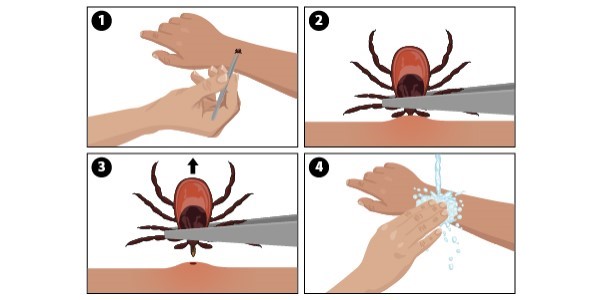Have you ever removed a tick from your skin with a pair of tweezers? If so, you know how important it is to clean those tweezers afterward. Ticks can carry harmful diseases, and if any of their bodily fluids remain on your tweezers, you could be at risk for infection. In this article, we’ll show you the best methods for cleaning your tweezers after tick removal to keep yourself safe and healthy.

How to Clean Tweezers After Tick Removal?
Removing ticks from your skin with tweezers is an effective way to prevent Lyme disease and other tick-borne illnesses. However, it’s important to properly clean your tweezers after use to prevent the spread of bacteria and infection. In this article, we will provide you with step-by-step instructions on how to clean your tweezers after tick removal.
Step 1: Disinfect the tweezers
After you have removed the tick with your tweezers, the first step is to disinfect them. To do this, you can use rubbing alcohol, hydrogen peroxide, or an antibacterial soap. Dip a cotton ball or swab in the disinfectant and wipe down the tweezers, making sure to get in between the tips and the handle. Allow the tweezers to air dry or use a clean towel to dry them off.
Step 2: Clean the tweezers with soap and water
Once the tweezers have been disinfected, the next step is to clean them with soap and water. Use a mild soap and warm water to clean the tweezers, making sure to get in between the tips and the handle. You can use a soft-bristled brush or toothbrush to clean any debris or dirt that may be stuck in the crevices. Rinse the tweezers with warm water and dry them off with a clean towel.
Step 3: Sterilize the tweezers
To ensure that your tweezers are completely free of bacteria and other pathogens, you should sterilize them. There are several ways to sterilize your tweezers, including boiling, using an autoclave, or using a UV sterilizer. Boiling is the easiest and most accessible method for most people. Simply place the tweezers in boiling water for 10-15 minutes, making sure to keep them submerged the entire time. Remove the tweezers from the water and allow them to cool before using them again.
Step 4: Store the tweezers in a clean, dry place
After you have cleaned and sterilized your tweezers, it’s important to store them in a clean, dry place. You can use a small plastic bag or container to store your tweezers, making sure to label them for future use. Avoid storing your tweezers in a damp or humid environment, as this can promote the growth of bacteria.
The benefits of cleaning your tweezers after tick removal
Cleaning your tweezers after tick removal is essential for preventing the spread of bacteria and infection. By properly disinfecting, cleaning, and sterilizing your tweezers, you can ensure that they are safe to use for future tick removals. This can also save you money, as you won’t need to replace your tweezers as frequently.
Tweezers vs. other tick removal methods
While there are several methods for removing ticks from your skin, using tweezers is one of the most effective. Tweezers allow you to grasp the tick as close to the skin as possible, which reduces the risk of leaving any parts of the tick behind. Other methods, such as using your fingers or a tick removal tool, may not be as effective and can increase the risk of infection.
Conclusion
Properly cleaning your tweezers after tick removal is essential for preventing the spread of bacteria and infection. By following these simple steps, you can ensure that your tweezers are safe to use for future tick removals. Remember to disinfect, clean, sterilize, and store your tweezers in a clean, dry place. By doing so, you can protect yourself and your family from tick-borne illnesses.
Frequently Asked Questions
In this section, you will find answers to some of the commonly asked questions about cleaning tweezers after tick removal.
What is the importance of cleaning tweezers after tick removal?
It is crucial to clean the tweezers after tick removal to prevent the spread of diseases. Ticks can transmit harmful pathogens such as Lyme disease, Rocky Mountain spotted fever, and many more. Cleaning the tweezers thoroughly after tick removal helps to eliminate any remaining pathogens and prevent their spread to other individuals or pets.
The cleaning process also helps to maintain the quality and durability of the tweezers. Proper cleaning ensures that the tweezers remain sharp and free from rust or corrosion, making them effective in future tick removals.
What materials do I need to clean my tweezers after tick removal?
To clean your tweezers after tick removal, you will need a few materials. These include rubbing alcohol, hydrogen peroxide or soap, a clean cloth or paper towel, and a small container or basin. You may also need a soft-bristled brush, such as a toothbrush, to clean hard-to-reach areas.
First, rinse the tweezers with warm water to remove any visible debris. Then, soak them in rubbing alcohol for at least 30 seconds. Alternatively, you can use hydrogen peroxide or soap to disinfect the tweezers. Finally, dry the tweezers with a clean cloth or paper towel and store them in a clean, dry place.
Can I clean my tweezers in the dishwasher?
No, you should not clean your tweezers in the dishwasher. The high temperatures and harsh detergents used in the dishwasher can damage the tweezers and cause them to rust or corrode. Additionally, dishwashers are not effective in removing stubborn debris or pathogens that may be present on the tweezers after tick removal.
It is recommended to clean tweezers manually using warm water, rubbing alcohol, or hydrogen peroxide. This method ensures that the tweezers are thoroughly cleaned and disinfected without causing any damage.
How often should I clean my tweezers?
You should clean your tweezers after each tick removal to prevent the spread of diseases and maintain their effectiveness. It is important to remove any remaining debris or pathogens from the tweezers to ensure that they are ready for future use.
If you frequently use your tweezers for tick removal, it is a good idea to clean them regularly, even if you have not used them recently. This helps to ensure that the tweezers remain clean and free from rust or corrosion.
What should I do if my tweezers are rusty or corroded?
If your tweezers are rusty or corroded, it is best to replace them. Rust and corrosion can weaken the tweezers, making them less effective in tick removal and increasing the risk of injury or infection.
Regular cleaning and proper storage can help to prevent rust and corrosion. It is also a good idea to invest in high-quality tweezers made from materials such as stainless steel or titanium, which are less likely to rust or corrode.
Proper Tick Removal
In conclusion, cleaning your tweezers after tick removal is a crucial step to prevent the spread of disease. By following these simple steps, you can ensure that your tweezers are clean and ready for future use.
Firstly, use rubbing alcohol or hydrogen peroxide to disinfect the tweezers. This will kill any bacteria or germs that may have been transferred from the tick.
Secondly, clean the tweezers with soap and water. This will remove any remaining debris or dirt on the tweezers.
Finally, store the cleaned tweezers in a clean and dry place. This will ensure that they remain hygienic and ready for future use.
By following these steps, you can ensure that your tweezers are clean and safe for future use. Remember, proper tick removal and post-removal care is essential to ensure your health and safety.

